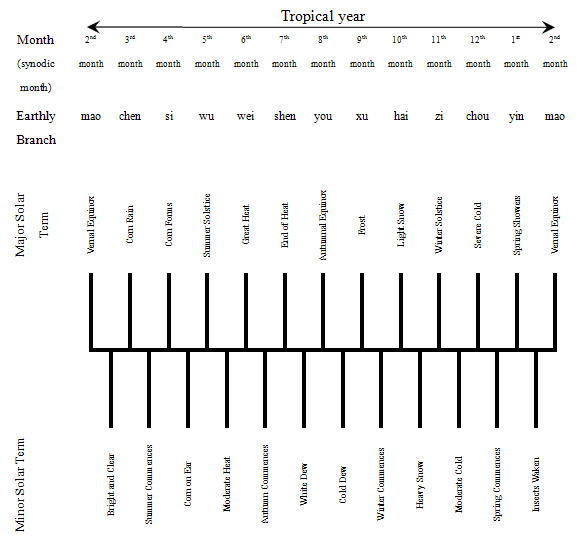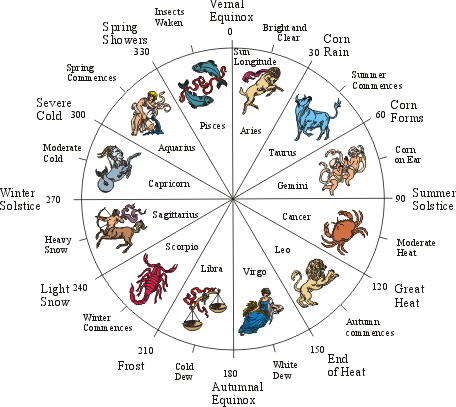The 24 Solar Terms
The 24 solar terms is a gross name of the system that comprises 12 major solar terms and 12 minor solar terms interlaced with each other. Starting from "vernal equinox", the 12 major solar terms are "vernal equinox", "corn rain", "corn forms", "summer solstice", "great heat", "end of heat", "autumnal equinox", "frost", "light snow", "winter solstice", "severe cold" and "spring showers". Each major solar term falls on one of the 12 lunar months designated by the 12 earthly branches (Figure 1). The minor solar term after "vernal equinox" is "bright and clear", and then in turn "summer commences", "corn on ear", "moderate heat", "autumn commences", "white dew", "cold dew", "winter commences", "heavy snow", "moderate cold", "spring commences" and "insects waken".

Figure 1 Tropical year, synodic months and the 24 solar terms.
From the Earth's perspective, the Sun moves through a year across the stars or celestial sphere along a path known as the ecliptic, which is measured in 360 degrees longitude. The 24 solar terms divide the ecliptic into 24 equal segments, with 15 degrees of the Sun's longitude between the terms. At "vernal equinox", the Sun's longitude is 0 degree; at "bright and clear", the Sun's longitude is 15 degrees; and so forth (Table 1).
Table 1 The 24 solar terms and the Sun's longitudes
| Sun's longitude | Major solar term | Minor solar term |
|---|---|---|
| 0° | Vernal Equinox | |
| 15° | Bright and Clear | |
| 30° | Corn Rain | |
| 45° | Summer Commences | |
| 60° | Corn Forms | |
| 75° | Corn on Ear | |
| 90° | Summer Solstice | |
| 105° | Moderate Heat | |
| 120° | Great Heat | |
| 135° | Autumn Commences | |
| 150° | End of Heat | |
| 165° | White Dew | |
| 180° | Autumnal Equinox | |
| 195° | Cold Dew | |
| 210° | Frost | |
| 225° | Winter Commences | |
| 240° | Light Snow | |
| 255° | Heavy Snow | |
| 270° | Winter Solstice | |
| 285° | Moderate Cold | |
| 300° | Severe Cold | |
| 315° | Spring Commences | |
| 330° | Spring Showers | |
| 345° | Insects Waken |
At "vernal equinox" and "autumnal equinox", the periods of daylight and the night are equal in length. The period of daylight is the longest at "summer solstice" and the shortest at "winter solstice" (northern hemisphere). These were the earliest solar terms determined in ancient time. Then it came the four solar terms "spring commences", "summer commences", "autumn commences" and "winter commences". Other solar terms were named later according to the weather and agricultural activities prevalent at the respective times of the seasons. The "24 solar terms" reflects to some extent the climate over central China in ancient time.
Each lunar month in the Agricultural Calendar contains a major solar term. A lunar month that does not include a major solar term is taken as the leap month of the preceding month. In 19 tropical years there will be 228 major solar terms and 235 synodic months. So 7 lunar months will not contain major solar terms and they are classified as leap months.
The 24 Solar Terms and the 12 Zodiac Constellations
Similar to the 24 solar terms, the 12 zodiac constellations were determined in the ancient time by dividing the zodiac (a band around the ecliptic) into 12 equal sectors measuring from the "vernal equinox" (Figure 2). Hence the start or end date of each zodiac sign in astrology always falls within about one day on a major solar term.

Figure 2 The 24 solar terms and the 12 zodiac constellations.
Remarks: The determination of the 12 zodiac constellations according to the Sun's longitude was made more than 2000 years ago. Due to precession of the Earth's rotation axis, the positions of the constellations as observed nowadays have already shifted to other longitudes.